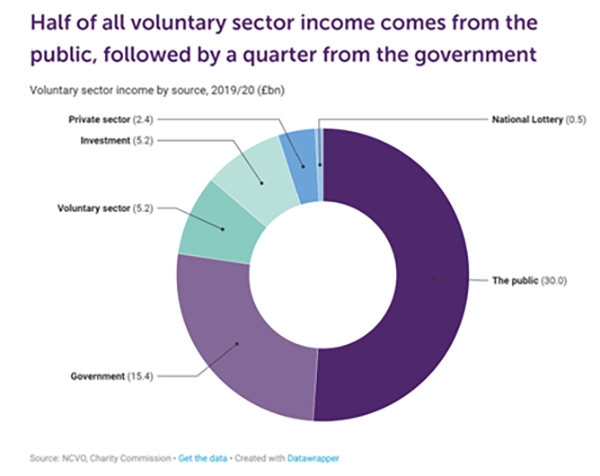Building a picture of VCSE strategies for raising money to serve mission & resilience
By Sam Magne, Knowledge and Learning Manager at The National Lottery Community Fund
As the cost-of-living bites, resilience is on everyone's minds. That's why we're keen to update you about new learning to help build future resilience of community organisations - and to encourage you to check this out in the light of your own insights….
The evaluation team working on our Growth Fund initiative is now looking beyond a group of charities and social enterprises who've used the initiative to access loans (also known as “working capital”) from social lenders. The team will work with a wider set of organisations from the voluntary, community and social enterprise (VCSE) sector to explore ways they manage cashflow and generate income too. We’re keen to share lessons from the bigger picture this phase of the evaluation offers, to help your organisations build resilience.
We know that income from voluntary sector funders and grant makers like The National Lottery’s distributors makes up a small proportion of the VCSE sector's total income. As illustrated by the figure below, most of the VCSE sector’s income comes from its amazing capability to raise donations from the public, win grants from government bodies and do trade with the public, government and businesses through contracts for services or sale of products that bring social value.

These different channels don't always flow at the right time, volume or with the flexibility needed to meet changes in demand for organisations’ services or in their development needs. Increasing numbers of VCSE organisations have been reaching out for small-scale working capital which, with Big Society Capital, we've been making available through a growing group of lenders developed under the Growth Fund, managed by Access - The Foundation for Social Investment. As its evaluation has shown, this flexible loan finance is helping many VCSE organisations make a step change in their business models - helping them grow, stabilise, or in the turbulent times we’ve seen, regroup and pivot.

Source: Pulling in the Right Direction thematic report, Ecorys UK Limited
The latest thematic report from the Growth Fund’s evaluation team offers a framework for characterising business models 'types'. Using Growth Fund investment case studies, it illustrates the degree to which a VCSE organisation’s product or service is, in itself, a social good or sold as a way of subsidising its social mission. And it places this in the context of whether the product or service is bought by beneficiaries themselves, or another party who is interested in them.
As the evaluation widens to include new case studies from outside Growth Fund’s investment cohort, we’ll learn more about the relationship between resilience and organisations’ different approaches to flexing their strategy across different business models. So far, as signalled in the report title ‘Pulling in the Right Direction’ the study flags the importance of getting the flex right for example too much stretch in the wrong direction can lead to strain on the business' social mission, undermining stakeholders’ confidence.
Along with trading income, it’s volunteer power and donations that play the lions share in resourcing VCSE activity. So, from a resilience perspective, funders may worry about individual VCSE organisations becoming 'dependent' on grants given their relatively small contribution. But in a turbulent world, reliance on any one channel of funding without the ability to flex by increasing or bringing another on tap fast, is perhaps the bigger issue.
Social investment schemes can help with cashflow while a VCSE organisation 'dials up' changes to its business model. So, to be useful, social lenders must make timely decisions and be ready to take risks. As a pathfinder, we funded Growth Fund lenders with a level of subsidy we estimated would make sufficient risk-bearing possible.
Subsidy levels need to be carefully calibrated to offset risk-bearing interest rates - otherwise these rates will show up in the fees that VCSE organisations then have to charge public sector commissioners for their services, or in the price of social value products. Diverting grant money into subsidising lending (rather than just giving it direct to VCSE organisations) is worthwhile, so long as it translates into the necessary risk appetite to get deals flowing where they’re needed, balanced with getting capital returned and recycled in more deals.
The evidence about how to get the right balance between subsidy, interest and, risk-rating, is gradually building. The evaluation has been probing what can hold social lenders’ and VCSE organisations risk-readiness back, including the risk aversion (or perhaps - misperception of risk) that some business models may at first appear to present. In the recently published summary evaluation update report, we’ve heard how social lenders are evolving to overcome commercial lending inhibitions, and in the current update you can see how they’re helping community organisations thrive.
A Rapid Evidence Appraisal has also set the scene for the next phase of the case study work, probing the context painted by external studies into VCSE resilience. By widening the pool of case studies beyond Growth Fund investees, we’re now keen to hear how other factors help VCSEs 'dial up or down' different resource channels to build resilience into their business models.
What stands out in your resilience story?
- Perhaps you have a flair for creative fundraising activities that appeal powerfully to people as their circumstances – and appetite for giving or buying - changes?
- Maybe you have a genius for designing products and spotting or switching between markets?
- Or perhaps you have a cautionary tale learned from a stretch too far from your core mission?
Whatever your experiences or wisdoms, you may find they resonate with some of the case studies and lessons being picked up in the Growth Fund research. So please do take a look at the links above, stay tuned to the emerging learning and check it out against your own resilience-building experience.